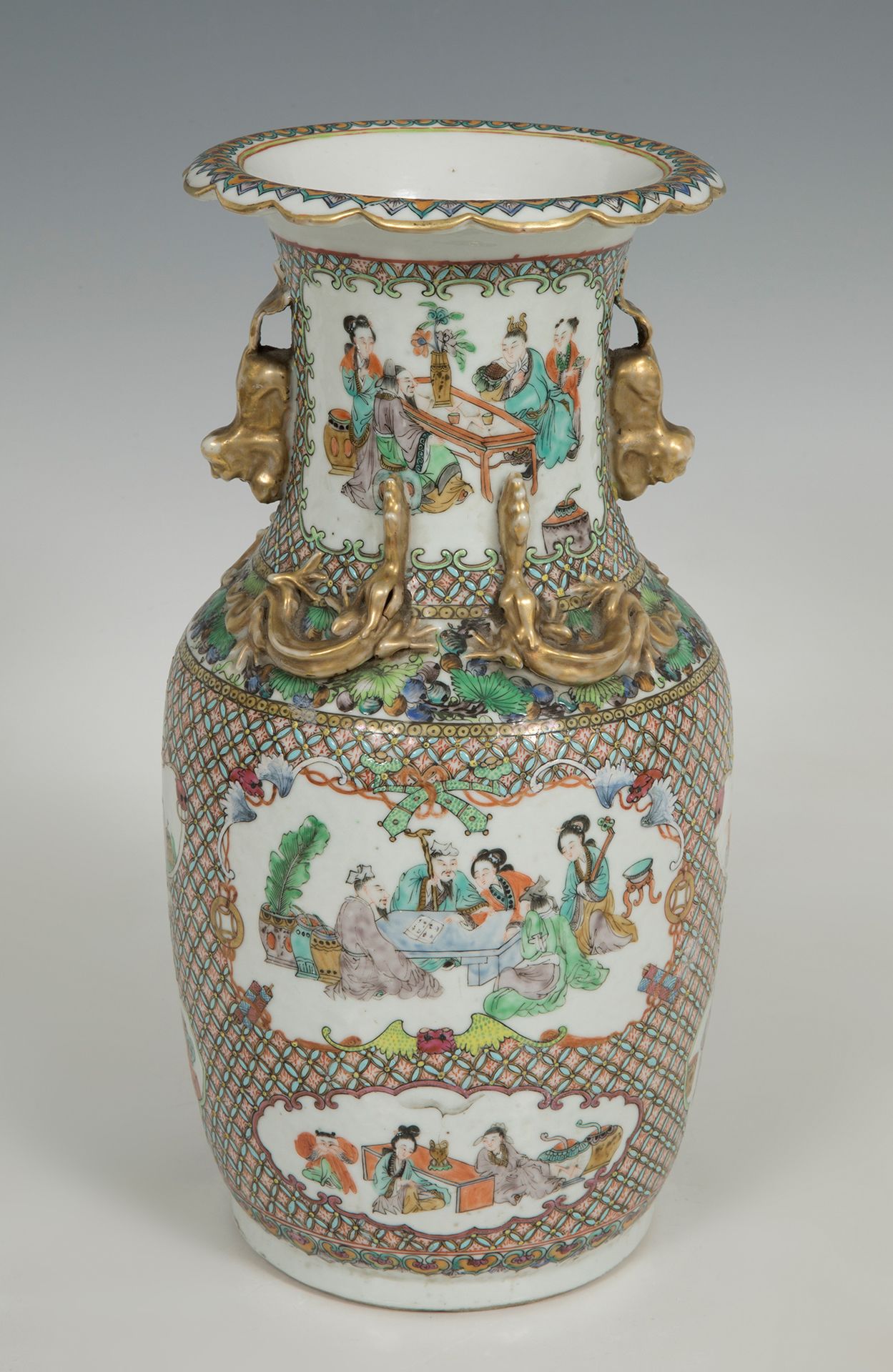Description
Vase. China, Canton, 19th century. Enamelled and polychrome porcelain. Pink family. The gilding is slightly worn. Measurements: 34 x 16 cm (diameter). The vases belonging to the Rose Family of Canton show a very frequent typology within Chinese production, derived from the old "zun", and combine enamelled decoration with relief motifs on the neck: serpentine dragons on the fronts and pairs of protective fo lions on the sides. The Pink Family of Canton style is characterised by the use of opaque white enamel and the predominance of light and very bright shades, especially pink and green. It is a style typical of ceramics exported to Europe, developed mainly during the second half of the 19th century. It is an ornate and highly ornamental style, usually decorated with figurative scenes, and mainly characterised by the use of a broader palette than that of the normal Rose Family, dominated by light and bright shades, mainly pinks and greens. Thanks to the discovery of the white glaze at the end of the Kangxi period (first half of the 18th century), Chinese potters broadened the palette, achieving new tonal ranges that allowed them to conform more closely to European tastes, even achieving gradations of colour. Furthermore, as can be seen here, these pieces are often enriched with gilt details, very much in keeping with Western tastes. Within the Canton Rose Family there are three styles: pink medallion, nyonya or straits and the Mandarin style. This pair of vases belongs to the first of these three styles, the rose medallion, introduced in 1860 and characterised by medallions in reserve, poly-lobed as here or peach-shaped, which house figurative scenes inspired by the old imperial court. They can be accompanied, as here, by other medallions, also in reserve, with motifs of flowers and insects. The backgrounds are entirely covered with flower motifs. They were made in Jingdezhen, the most important centre of pottery and porcelain production in China, from where they were brought undecorated to Canton, an important port where they were decorated with enamels and sold to foreign customers.
30
Vase. China, Canton, 19th century. Enamelled and polychrome porcelain. Pink family. The gilding is slightly worn. Measurements: 34 x 16 cm (diameter). The vases belonging to the Rose Family of Canton show a very frequent typology within Chinese production, derived from the old "zun", and combine enamelled decoration with relief motifs on the neck: serpentine dragons on the fronts and pairs of protective fo lions on the sides. The Pink Family of Canton style is characterised by the use of opaque white enamel and the predominance of light and very bright shades, especially pink and green. It is a style typical of ceramics exported to Europe, developed mainly during the second half of the 19th century. It is an ornate and highly ornamental style, usually decorated with figurative scenes, and mainly characterised by the use of a broader palette than that of the normal Rose Family, dominated by light and bright shades, mainly pinks and greens. Thanks to the discovery of the white glaze at the end of the Kangxi period (first half of the 18th century), Chinese potters broadened the palette, achieving new tonal ranges that allowed them to conform more closely to European tastes, even achieving gradations of colour. Furthermore, as can be seen here, these pieces are often enriched with gilt details, very much in keeping with Western tastes. Within the Canton Rose Family there are three styles: pink medallion, nyonya or straits and the Mandarin style. This pair of vases belongs to the first of these three styles, the rose medallion, introduced in 1860 and characterised by medallions in reserve, poly-lobed as here or peach-shaped, which house figurative scenes inspired by the old imperial court. They can be accompanied, as here, by other medallions, also in reserve, with motifs of flowers and insects. The backgrounds are entirely covered with flower motifs. They were made in Jingdezhen, the most important centre of pottery and porcelain production in China, from where they were brought undecorated to Canton, an important port where they were decorated with enamels and sold to foreign customers.
